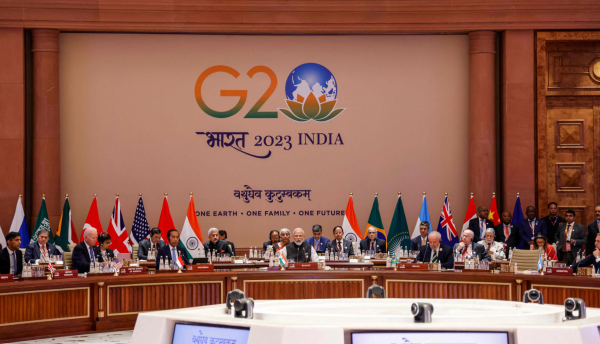India is growing in importance. But how much more important will it become? In the lead-up to the Group of 20 summit in New Delhi, major newspapers, billboards and bus stops in every Indian city proclaimed India as a “Vishwaguru”, or teacher to the world.
This is baffling. What would India teach the world? It has never been shy to describe itself as the world’s largest democracy. But the Indian government, led by Prime Minister Narendra Modi, is increasingly being criticised as authoritarian and repressive. On September 18, Canada’s Prime Minister Justin Trudeau told the country’s parliament of “credible allegations” that linked the killing of a prominent Canadian Sikh to “agents of the government of India”.
While the advance of what is now the world’s fifth-largest economy has been impressive, even if India could sustain annual growth of 5 per cent, its gross domestic product per head would reach about 30 per cent of the United States’ levels, roughly where China’s is today, in 2050. Meanwhile, Beijing has lifted hundreds of millions out of poverty in four decades. Needless to say, China has more to share with other developing countries on ways of achieving economic development.
In January, Modi hosted a virtual Voice of Global South Summit for 125 developing countries, but didn’t invite China, Brazil or South Africa. Presumably, in the presence of these leading developing nations, India would have felt embarrassed to describe itself as the voice of the Global South.
India’s real advantage is that, as a middle power, it can capitalise on major-power competition. With regard to the war in Ukraine, while both China and India have adopted a studied neutrality, Washington has set aside its frustration at New Delhi because of its long-term strategic need to draw India closer and counter China. This is how India succeeded in persuading the US and Europe to agree to a softened G20 statement on the Russian invasion of Ukraine. Clearly, such a consensus would have been harder to reach with China as G20 host.

However, India is unable to play a “central role” in facilitating an end to the hostilities in Ukraine, despite what Italian Prime Minister Giorgia Meloni suggested. There are already several peace plans on the table, including one from China. None of them will work unless Moscow and Washington, rather than Moscow and Kyiv, can agree a deal. If Russia will listen to anyone, it is more China than India.
India depends on Russia for weaponry and energy. But, according to Alexander Gabuev, director of the Carnegie Russia Eurasia Centre, Russia’s reliance on China will outlast Vladimir Putin, in that Russia is increasingly dependent on China as a market for its commodities, as a source of critical imports, and as its most important diplomatic partner.
In the long term, the Indian-Russian relationship is on a downward trend, although it won’t break. For decades to come, India will still need Russian oil and gas, but it will reduce its dependence on Russian arms. Due to the war in Ukraine, Russia has already fallen behind schedule in delivering Talwar-class stealth frigates to India.
Washington would be only too happy to wean New Delhi off Russian dependency. It remains to be seen whether increasing US-India defence industrial cooperation can really bolster New Delhi’s defence manufacturing capabilities, or if India’s defence sector will end up a bigger hodgepodge of everything from everywhere.
New Delhi’s biggest challenge is maximising gains from its relations with a faraway Washington without irking Beijing, its stronger neighbour. India is now being wooed by the US as China was once cozied up to by the US against the Soviet Union during the Cold War. This is certainly an opportune moment for New Delhi to seize. If pretending is an art, then Modi is a guru second to none.
For example, he has echoed the US’ call for a “free and open Indo-Pacific”, even though India’s position on maritime law is closer to China’s than the US’. Both China and India have been challenged by the US Navy with its freedom of navigation operations in their exclusive economic zones. The difference is that the Chinese Navy will definitely react, while the Indian Navy will pretend nothing has happened.
Detente between China and India would serve both countries’ interests. For instance, India’s pharmaceutical industry, a big exporter, gets 70 per cent of active ingredients from China. Likewise, India is a vast market for China. This explains why, in spite of complaints about India’s domestic environment, Chinese companies are still considering investing in India.
Unless there is a border war between China and India, New Delhi won’t be a willing pawn for Washington. The likelihood of a conflict between China and India is low. While it is true that the two sides had a deadly brawl in the Galwan valley in June 2020, it was the first case with casualties in over 40 years.
The fact that the soldiers from both sides were fighting with stones and clubs tells us that they knew they shouldn’t shoot at each other in any circumstances. If a lesson has truly been learned, it is entirely possible for both sides to maintain peace in the border area, at least for four more decades.
India’s foreign policy is at best pragmatic and at worst opportunistic, but trying to be all things to all people won’t make India a “Vishwaguru”. Instead, India comes across more as the bat from Aesop’s fable, which describes itself as a bird or a beast depending on its assessment of an impending war between birds and beasts. But India is not alone in this. In a world of intensifying major-power competition, there are more bats than birds or beasts.
(This article was first published on South China Morning Post on Sep. 27, 2023.)
